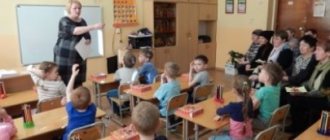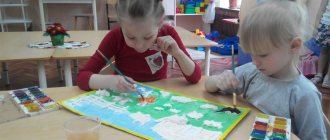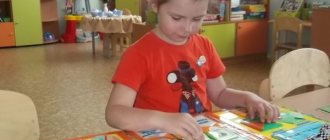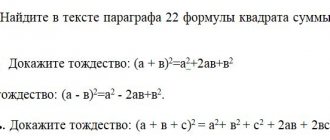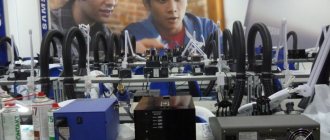Innovative activities of primary school teachers. educational material
The innovative activity of a teacher in modern education is the most important component of the educational process. I see two components in this concept: it is something new compared to the previous one, and this new thing is aimed at improving the quality of education.
A teacher learns all his life - this is a well-known truth. I'm not an exception. I am in constant development and throughout my teaching career I try to be a researcher. Scientific and methodological activities have a particularly great influence on the formation of my professionalism. This activity involves:
— constant familiarization with modern scientific research by scientists.
— studying the progressive experience of colleagues.
— familiarization with new programs and concepts for raising and educating children according to the Federal State Educational Standard.
My teaching activity is to create the most favorable conditions for the development of all categories of students in the classroom. The curriculum, programs and teaching aids make it possible to make learning dependent on the abilities and interests of each student. I am interested in issues related to the introduction of computer technology into the teaching process in primary school. In my work I use modern educational technologies:
- ICT
- Level differentiation technology
- Gaming technologies
- Problem-based learning
- Group technologies
- Personally-oriented developmental training
- Project-based learning
The use of modern technology is facilitated by the equipment in my office. It is equipped with modern equipment:
- a computer connected by a local network;
-Multi-projector;
-TV;
-A printer;
- Scanner
I implement ICT at the following stages of work:
1) when presenting new material - visualization of knowledge (demonstration - encyclopedic programs; PowerPoint presentation program);
2) in consolidating program material (training - various training programs);
3) in the control and verification system (testing with assessment);
4) in independent work;
5) in conducting integrated classes using the project method;
6) in the formation and development of research skills and creative abilities of students
I pay special attention to multimedia presentations. They contribute to the assimilation of theoretical material not only through the activation of mental activity, but also through the possibility of transferring knowledge in the presence of identical elements from the experience of past activities.
Multimedia tools significantly expand the possibilities of presenting educational information. The use of color, graphics, sound, and all modern multimedia tools allows you to create an active cognitive process and increase the interest of schoolchildren in educational activities. ICTs can significantly increase the level of assimilation and retention of educational material.
During my lessons, I use a specially developed system of computer tests, which allows me to control the level of proficiency in spelling and punctuation, as well as identify the causes of errors during testing and receive a reasonable individual recommendation that helps to avoid mistakes in the future. The student himself sets the pace of work and answers to questions, and immediately receives a grade for his work. He can use the hint and see the number of mistakes made. Of course, the advantage of using computer programs for the Russian language in the classroom is undeniable: this includes operational control of knowledge, which provides significant savings in teacher time, and an element of entertainment that increases students’ interest in learning, and the creation of conditions for individual work. Thanks to computer tests, students acquire self-monitoring skills for mastering educational material.
All this work contributes to students’ awareness of their capabilities and mental abilities, understanding of educational tasks, the formation of sustainable interests in studying the Russian language, literary reading, mathematics, the world around them, the development of creative potential, and increased motivation for learning. All this allows us to achieve positive results.
In her office, she created a library of teaching materials for successful work in primary grades: the magazines “Primary School”, “Pedagogical Council”, “Handbook of the Class Teacher”, the newspaper “Primary School September 1”, Internet site addresses.
The classroom is constantly updated with visual aids and educational CDs on subjects. I designed some of the handouts myself. I am replenishing my office with methodological literature. For each subject there are folders for storing various visual and didactic material.
The activity of a teacher is a continuous search for methods to achieve positive results in teaching and education. Personal experience, attending lessons and classes of other teachers, studying best practices allows me to use various teaching technologies in my work. Thus, in my practice I am based on personality-oriented, individual, competency-based approaches.
I believe that the basis of successful personality development is cognitive interest. Cognitive interest is the most important personality quality, which is formed in social conditions and is not inherent in a person from birth. In learning conditions, cognitive interest is expressed by the student’s disposition to study, to cognitive activity in the field of one, and perhaps a number of academic subjects.
In my lessons I use the following ways to increase cognitive interest:
- Enriching the content with material on the history of science.
- Solving tasks of increased difficulty and non-standard tasks.
- A variety of lessons, their non-standard construction, the inclusion of elements that give each lesson a unique character, the use of ICT, visual aids, a variety of mental calculations (in mathematics lessons), the availability of materials for experiments (in lessons of the surrounding world), creative tasks, didactic games, etc. .
- Activation of students' cognitive activity in the classroom using forms of independent and creative work.
- Using various forms of feedback: systematic surveys, short-term oral and written tests, various tests, dictations on subjects along with tests provided for in the plan.
- Variety of homework.
- Establishing internal and interdisciplinary connections by demonstrating and explaining the application of knowledge in life.
Thus, by creating cognitive interest, I provide a favorable learning atmosphere, the movement of my students towards solving those goals, those tasks that are posed by training. Depending on the approaches to achieving my learning goals, I choose the following technologies:
- Technology of personality-oriented lesson M.I. Lukyanova
- Multi-level training
- Information Technology
- Project method
- Humanitarian technologies
By studying pedagogical literature, the experience of people in one way or another connected with pedagogy, I try to master humanitarian technologies.
An important role in organizing stimulating dialogue is played by the creation of various situations in the lesson.
1. Creating a “situation of success.” Children are given a task based on their existing experience. Everyone solves the problem individually without experiencing any difficulties. As a result, children achieve emotional satisfaction with their knowledge.
2. The situation of “intellectual gap”. A practical problem is proposed that is similar in appearance, but which students can no longer solve, since it is focused on a new method of solution. The result is an emotional experience of universal failure (no one can). This is a positive emotion, since there is no experience of one’s failure against the background of the success of others.
3. Formulating a learning task together with the teacher. Children must experience a deficit in their abilities. Analyze the situation of a practical difficulty: where and why did the problem arise? Then the learning task appears. "What will we do next?". Students formulate the question themselves and look for an answer. The dialogue develops from the issues that concern the child. The setting of an educational task occurs in the form of a stimulating dialogue, and its solution in the form of a leading dialogue.
Project method. This is a way to achieve a didactic goal through a detailed development of a problem (technology), which should result in a very real, tangible practical result, formalized in one way or another; This is a set of techniques and actions of students in their specific sequence to achieve a given task - solving a problem that is personally significant for students and is presented in the form of a certain final product. In elementary grades, the use of this method is most appropriate, in my opinion, in grades 3-4. At this age, students most consciously approach the choice of a project topic, taking into account its practical significance and relevance. They already know how to independently construct their knowledge, navigate the information space, and have developed critical and creative thinking.
At the first stage of working with children, the priority method of work was didactic play. It contributed not only to a positive attitude of interest in learning, but also reduced motor disinhibition and increased excitability. Playful activities helped my students develop elements of fantasy, traits of independence, activity, and the ability to concentrate, which in turn directed their activities towards solving educational problems. In my lessons, every child learns to formulate and express their opinion, defend it, and also admit that they are wrong or make mistakes.
I work on speech development taking into account the fact that most children have a very poor vocabulary and there are violations of the grammatical structure of speech. During extracurricular reading lessons, I introduce children to oral folk art: we read riddles, fairy tales, tongue twisters, proverbs and sayings, this helps teach correct speech, enrich them emotionally, develop morally and spiritually.
I try to work on developing creative potential in children. I develop such qualities as activity, curiosity, imagination, vigilance, optimism, speed and flexibility of thinking.
In search of ways to more effectively use working time, the forms of organizing students' educational activities in the classroom become of particular importance. For example: collective and group classes, lectures, seminars, conferences, Olympiads, excursions, business games
My students are regular participants in the school scientific and practical conference “I Explore the World.” The guys receive high marks and are recognized by the jury in various categories.
Circle work.
Club "Young Theatregoer"
I conduct club classes once a week according to the thematic plan.
Theatrical art has irreplaceable possibilities for spiritual and moral influence. A child who finds himself in the position of an actor-performer can go through all the stages of artistic and creative understanding of the world, which means thinking about what and why a person says and does, how people understand it, why show the viewer what you can and want play what you consider dear and important in life.
The program is based on the idea of using the potential of theater pedagogy, which allows you to develop the child’s personality, optimize the process of development of speech, voice, sense of rhythm, and plastic movements.
The work is aimed at implementing the following tasks:
- spiritual and moral development of students. Mastering the moral, aesthetic and socio-historical experience of humanity, reflected in material culture;
- the formation of a holistic picture of the world, material and spiritual culture as a product of creative subject-forming human activity;
- formation of motivation for success and achievements, creative self-realization, interest in subject-transforming, artistic and design activities;
formation of an internal activity plan based on the stage-by-stage development of subject-transformative actions, including goal setting, planning, forecasting, control, correction and evaluation.
The goal of the program: harmonious development of the child’s personality through aesthetic education; development of his artistic and creative skills; moral formation.
As a result of mastering the program of the theater club “Theater”, students receive a whole range of knowledge and acquire certain skills. By the end of the year they should:
- Be able to correctly assess the consequences of human activity and one’s own actions;
- To achieve a state of acting freedom, to be able to live out one or another literary plot using the sketch method, to improvise in a fairly short period of time;
- Cultivate in yourself such qualities as responsiveness, empathy, desire to help, self-esteem, confidence;
- Master communication skills, adapt quickly, feel comfortable in any environment.
Circle "Cross stitch"
At the embroidery club, my work with children is aimed at:
-increasing interest in the cultural traditions of the native land;
-development of cognitive and creative activity of children;
-formation of moral values;
-expansion of polytechnic knowledge; -improving the culture of communication between children;
-strengthening children's faith in their abilities.
During the club's classes, children will become familiar with the history of embroidery among the peoples of the world. They learn to independently design and execute compositions for creative works. The proposed work allows students to broaden their horizons, deepen their knowledge and creative activity in the field of traditional culture of their native land. In the course of work, the children master the skills of hand embroidery and the ability to organize their activities, which will help in their future careers.
Innovative activities in institutions of additional education for children
Municipal budgetary educational institution of additional education for children Palace of Creativity of Children and Youth of the Tolyatti Urban District
Innovative activities in institutions of additional education for children
Methodist
Baiditskaya Lyubov Ivanovna
Tolyatti, 2015
Innovative activities in institutions of additional education for children
Innovation processes are implemented today in almost all spheres of human activity. Innovation in institutions of additional education is a fairly important and necessary mechanism of creative activity, which distinguishes one educational institution from another. That is why one of the areas of activity of the municipal budgetary educational institution of additional education for children, the Palace of Creativity of Children and Youth of the city of Tolyatti, is effective innovative activity, as a process of mastering those components that allow us to achieve qualitatively new results and become increasingly attractive and necessary for children and their parents.
Undoubtedly, the teacher occupies a key position in the educational process: the effectiveness of solving many problems in the institution depends on his qualifications, professionalism, and personal qualities.
New trends of the times require additional education teachers to take a constant active position and go beyond their narrow world of teaching in a specific children’s community.
If for a teacher working in a traditional system, the main thing was special and methodological knowledge, it was enough to master pedagogical techniques, have pedagogical skills that allow him to carry out the educational process at a professional level and achieve its high efficiency, then for the transition to an innovative mode, the teacher’s readiness is decisive Theoretical (knowledge of modern psychological and pedagogical concepts), methodological (knowledge of the general principles of studying pedagogical phenomena, patterns of socialization of teaching and upbringing) and technological (knowledge of not only traditional, but also innovative educational technologies) become a priority for innovation.
A modern teacher is not only a teacher who imparts knowledge to the classroom (which is naturally important, but very narrow at the moment). The professional activity of a teacher is incomplete if it is constructed only as a reproduction of work methods once learned, if it does not realize objectively existing opportunities for achieving higher educational results, if it does not contribute to the development of the personality of the teacher himself. Without creativity there is no teacher - a master. Today, the reality is such that it is necessary to constantly grow professionally. The new form of certification places the same demands on teachers.
Of particular importance in the process of professional self-improvement of a teacher is his innovative activity.
Innovative activity is a purposeful activity based on understanding (reflection) of one’s own practical experience through comparison and study, change and development of the educational process in order to achieve better results, obtain new knowledge, and qualitatively different teaching practice.
In this regard, the formation of a teacher’s readiness for it is the most important condition for his professional development.
The innovative activity of a teacher depends on:
on the level of personal readiness of the teacher
to this activity, the set of qualities of a teacher that determine his focus on improving his own pedagogical activities:
- personal
(performance, readiness for creativity, high emotional status);
- special
(knowledge of new technologies, mastery of new teaching methods, the ability to analyze and identify the causes of shortcomings, find current problems in education and implement effective ways to solve them).
- existing
in a specific
educational institution conditions:
- financial interest: additional payments, bonuses;
- favorable moral and psychological microclimate and creative atmosphere;
- assistance in obtaining information about innovative technologies;
- assistance to the administration of the institution in the relations of cooperation between the teacher and students and colleagues
- correct selection of the most significant incentives in accordance with the specifics of their relationship and taking into account the influence of barriers.
Based on the results of the testing conducted at MBOUDOD DTDM “ Innovative activities of a teacher
“It was revealed that some teachers are inclined to accept innovations, others are more conservative. The attitude towards innovation among the Palace teachers is as follows:
- those who want to work in an innovative mode
(innovators) - make up 3.2% of the team, they are always open to new things and active;
- supporting innovation
(leaders) - 34.7% rarely act as leaders; it takes them much more time to make a decision than the leading groups,
- moderate - 15.7%, begin to master innovations, sometimes under pressure from the social environment, sometimes as a result of assessing their own needs, but under one condition: when they feel the support of the team,
- reserved towards innovation
— about 47% are guided by traditional values and make the decision to adopt innovations with great difficulty.
The following factors negatively affect the innovative activity of a teacher:
- low level of wages (98% of respondents);
- formal requirements and often biased assessment on the part of the administration (28% of respondents);
- insufficient educational and material base (73% of respondents);
- insufficient information about innovative technologies of interest to teachers (98% of respondents);
- students' desire to learn is not clearly expressed (98% of respondents).
Such factors hinder the desire to participate in innovative activities and to professional and creative freedom.
At its core, novelty is always relative. Innovation is not necessarily something new, but it is definitely something better and can be demonstrated in its own right.
Innovations of an institution’s teacher can be presented as:
— absolute novelty (absence of analogues and prototypes in this area),
- relative novelty (introducing some changes to existing practice).
A teacher’s source of innovative ideas can be:
- an event unexpected for the teacher himself (success, failure, as an impetus for the development of activities);
- various inconsistencies (between the true motives of children’s behavior, their requests, desires and practical actions of the teacher);
— the needs of the pedagogical process (weaknesses in the methodology, search for new ideas);
- changes in the values and attitudes of children (entails the search for new forms of communication and professional behavior), etc.
Contents of innovative activities of a teacher
1. Introduction and use of new methods, techniques, tools, technologies in the educational process.
2. Development of proprietary programs, methods, technologies, projects, methodological products.
3. Conducting training sessions in innovative forms.
4. Conducting master classes at the municipal level
5. Participation in design, research or experimental activities.
To carry out innovative activities, the teacher can work alone
or
teachers can join groups
:
— MO on a specific topic or area of activity;
- problem (creative) groups in which teachers from different directions unite for certain tasks in organizing and implementing the educational process.
How can a teacher position himself and declare for the implementation of innovative activities? At the center there is a certain algorithm for the teacher’s actions.
The procedure for organizing and conducting innovative activities of a teacher presupposes:
— choosing a topic
innovative activities, taking into account the age characteristics of students and in accordance with the goal of the International Educational Institution of Education and Science (MTDM) (it can also become a topic for teacher self-education);
— filling out the information card
innovation activity (application);
- initial expert assessment of the innovation announced by the teacher
- development of a project (program, plan)
innovation activity: purpose of research, objectives, subject, novelty, practical significance, relevance, evaluation criteria, forms of control and diagnostics, main stages of work, duration, expected result. A teacher who has expressed a desire to work according to his own author’s program provides the MS with a document on external examination of the program;
— implementation of innovative activities
(implementation of an innovative
project (program) ;
- report on the implementation of innovation.
Various forms of familiarization with the progress, methods and results of innovation activities are provided:
«Creative reports"
They allow us to evaluate the overall effectiveness of innovation activities, to see the differences that innovation brings with it to the life of the team, students, and their parents.
«Open events"
allow you to directly get acquainted with the creative activity of the teacher.
«Methodical exhibitions"
They allow you to get acquainted with the new developments of the team’s teachers, and offer materials that can be used by teachers who are mastering any innovation.
«Thematic consultations"
allow other interested teachers of educational institutions to obtain additional information on various innovations.
"Problem seminars"
are of particular interest to those who, in the process of mastering innovation, have already felt the need for deeper theoretical training.
"Free attendance"
a teacher implementing innovation;
— introduction of innovation (
dissemination of innovatively created experience and new practices).
Annex 1
Instructions for filling out the information card
“Characteristics of innovations and innovations”
It is best to fill out the card at the beginning of the school year.
1. Problem.
It is necessary to think about what contradictions in the practice of education force one to abandon the traditional path and start searching for a new one, or what needs determine the need for this innovation. The problem is written as a contradiction. For example, “the need to provide pedagogical support to students and the lack of knowledge among educators about this technique for implementation in practice.”
2. The purpose of innovation, innovation.
To formulate a goal, you need to pay attention to the second part of the problem (contradiction) and answer the question: “What is it desirable to create as a result of the work?” The purpose of any innovation is stated in verbal form. For example, “to develop and master a new method of pedagogical support for students.”
3. The essence of innovation, innovation.
The essence of innovation is a detailed goal, a set of tasks that need to be solved. For example: “to gradually develop and implement methods of pedagogical support in the educational process.”
4. The predicted result of the innovation.
Any predicted result must contain indicators of achievability, reality and measurability. The following are predicted: possible (expected) positive results; possible losses, negative consequences; compensatory measures to eliminate them.
The parameters by which the effectiveness of the innovation will be determined are also indicated.
5. Classification of innovations by area of application of knowledge.
It is necessary to emphasize or add which areas of knowledge the innovation concerns.
6. Innovator.
Information is recorded about who is introducing the innovation in a given class or school. Emphasize who he is in relation to this innovation (developer, user, distributor).
7. Stages of innovation.
Emphasize all the stages that a particular innovation has gone through in the classroom or school, including the stage at which it is currently located.
8. The innovation has been experimentally tested.
The frequency of inspections is calculated at the end of the school year.
9. The nature of the innovation process (experiment or experience).
Ascertainer – tracking the process, stating the results.
Clarifying – adjusting the hypothesis in accordance with the results.
Formative – design and description of educational technology and expected results.
An active experiment is of a laboratory, industrial nature.
Passive experiment – pedagogical observation.
10. Obstacles to development and implementation.
Problems that hinder the implementation of innovation: social, legal, logistical, financial, as well as general pedagogical (managerial, private methodological, educational, etc.).
11. Experimental control is carried out...
Experts can be fellow teachers, experienced school leaders, methodologists, scientists, etc. Public control is carried out by parental, student, trade union organizations, school governing boards, etc. Self-control is necessary for developers, distributors and users of innovations.
12. Evaluation of innovation.
It is given taking into account the data from card 2 “Control and expert assessment of the result of innovation.”
13. What other problems remain to be solved?
Description of obstacles to the implementation of innovation. For example: psychological barrier among educators, lack of private experience in using pedagogical support for students, etc.
14. Special notes on the meaning of innovation...
Filled out based on the results of the examination of the innovation and innovation program.
Data from completed cards can be entered into the computer.
Appendix 2
Diagnostic card
“Assessing a teacher’s readiness to participate in innovative activities”
Instructions:
Rate the proposed criteria for your readiness
on a 5-point scale.
| № | Criteria | 1 | 2 | 3 | 4 | 5 | |||
| I. _ Motivational and creative orientation of the individual | |||||||||
| 1 | Interest in creative activities | ||||||||
| 2 | Striving for creative achievements | ||||||||
| 3 | Striving for Leadership | ||||||||
| 4 | The desire to receive high praise from the administration | ||||||||
| 5 | Personal significance of creative activity | ||||||||
| 6 | Striving for self-improvement | ||||||||
| Total: | |||||||||
| II . Teacher creativity | |||||||||
| 7 | The ability to abandon stereotypes in teaching activities, overcome the inertia of thinking | ||||||||
| 8 | Risk taking | ||||||||
| 9 | Critical thinking, ability to make value judgments | ||||||||
| 10 | Ability for self-analysis and reflection | ||||||||
| Total: | |||||||||
| III . Professional abilities of a teacher to carry out innovative activities | |||||||||
| 11 | Mastery of pedagogical research methods | ||||||||
| 12 | Ability to plan experimental work | ||||||||
| 13 | Ability to create an original concept | ||||||||
| 14 | Ability to organize an experiment | ||||||||
| 15 | The ability to correct one’s activities | ||||||||
| 16 | The ability to use the experience of creative activity of other teachers | ||||||||
| 17 | Ability to collaborate | ||||||||
| 18 | Ability to creatively resolve conflicts | ||||||||
| Total: | |||||||||
| IV . Individual characteristics of a teacher | |||||||||
| 19 | Performance in creative activities | ||||||||
| 20 | Self confidence | ||||||||
| 21 | Responsibility | ||||||||
| Total: | |||||||||
Thank you!
Processing the results:
Based on the results obtained, the following conclusions are drawn:
• about the high level of teacher readiness to participate in innovative activities - scored from 84 to 71 points;
• average level – from 70 to 55 points;
• low level – less than 55 points.
